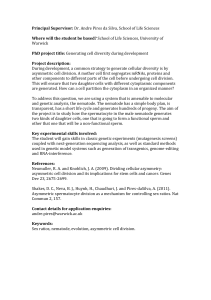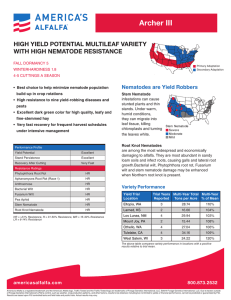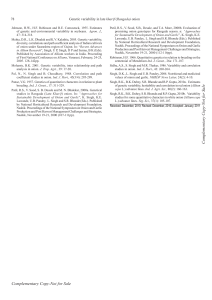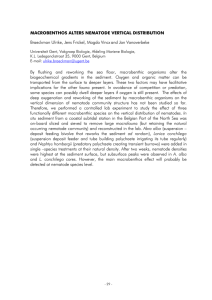Effect of Glomus fasciculatum on the growth and yield of tomato
advertisement
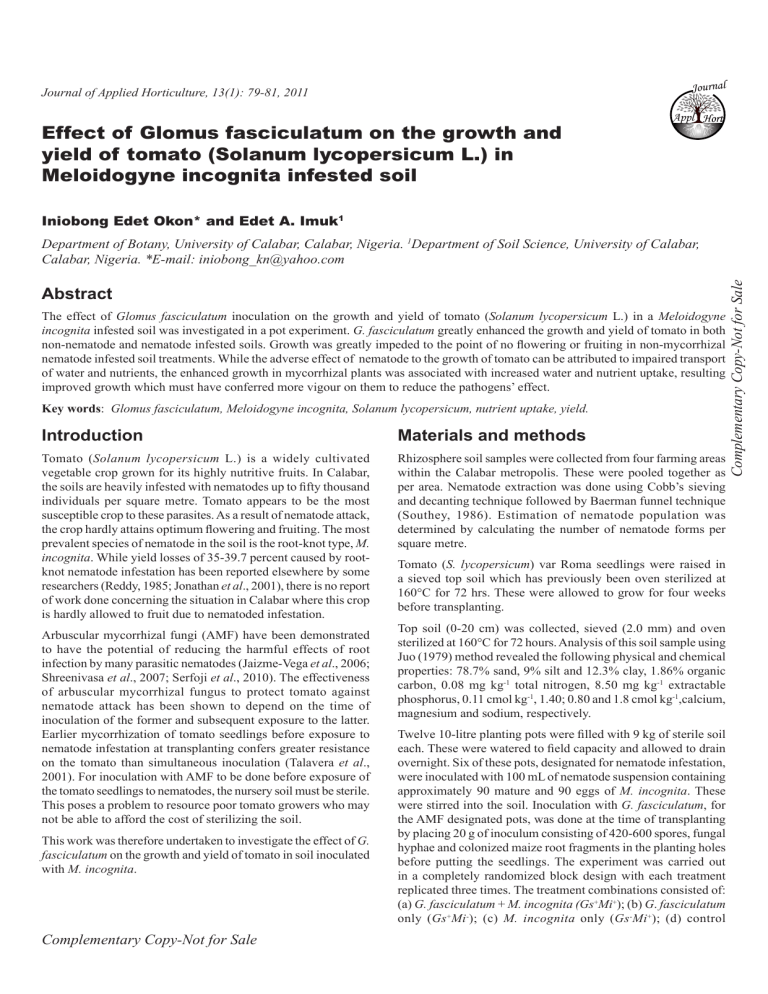
Journal Journal of Applied Horticulture, 13(1): 79-81, 2011 Effect of Glomus fasciculatum on the growth and yield of tomato (Solanum lycopersicum L.) in Meloidogyne incognita infested soil Appl Iniobong Edet Okon* and Edet A. Imuk1 Abstract The effect of Glomus fasciculatum inoculation on the growth and yield of tomato (Solanum lycopersicum L.) in a Meloidogyne incognita infested soil was investigated in a pot experiment. G. fasciculatum greatly enhanced the growth and yield of tomato in both non-nematode and nematode infested soils. Growth was greatly impeded to the point of no flowering or fruiting in non-mycorrhizal nematode infested soil treatments. While the adverse effect of nematode to the growth of tomato can be attributed to impaired transport of water and nutrients, the enhanced growth in mycorrhizal plants was associated with increased water and nutrient uptake, resulting improved growth which must have conferred more vigour on them to reduce the pathogens’ effect. Key words: Glomus fasciculatum, Meloidogyne incognita, Solanum lycopersicum, nutrient uptake, yield. Introduction Materials and methods Tomato (Solanum lycopersicum L.) is a widely cultivated vegetable crop grown for its highly nutritive fruits. In Calabar, the soils are heavily infested with nematodes up to fifty thousand individuals per square metre. Tomato appears to be the most susceptible crop to these parasites. As a result of nematode attack, the crop hardly attains optimum flowering and fruiting. The most prevalent species of nematode in the soil is the root-knot type, M. incognita. While yield losses of 35-39.7 percent caused by rootknot nematode infestation has been reported elsewhere by some researchers (Reddy, 1985; Jonathan et al., 2001), there is no report of work done concerning the situation in Calabar where this crop is hardly allowed to fruit due to nematoded infestation. Rhizosphere soil samples were collected from four farming areas within the Calabar metropolis. These were pooled together as per area. Nematode extraction was done using Cobb’s sieving and decanting technique followed by Baerman funnel technique (Southey, 1986). Estimation of nematode population was determined by calculating the number of nematode forms per square metre. Arbuscular mycorrhizal fungi (AMF) have been demonstrated to have the potential of reducing the harmful effects of root infection by many parasitic nematodes (Jaizme-Vega et al., 2006; Shreenivasa et al., 2007; Serfoji et al., 2010). The effectiveness of arbuscular mycorrhizal fungus to protect tomato against nematode attack has been shown to depend on the time of inoculation of the former and subsequent exposure to the latter. Earlier mycorrhization of tomato seedlings before exposure to nematode infestation at transplanting confers greater resistance on the tomato than simultaneous inoculation (Talavera et al., 2001). For inoculation with AMF to be done before exposure of the tomato seedlings to nematodes, the nursery soil must be sterile. This poses a problem to resource poor tomato growers who may not be able to afford the cost of sterilizing the soil. This work was therefore undertaken to investigate the effect of G. fasciculatum on the growth and yield of tomato in soil inoculated with M. incognita. Complementary Copy-Not for Sale Tomato (S. lycopersicum) var Roma seedlings were raised in a sieved top soil which has previously been oven sterilized at 160°C for 72 hrs. These were allowed to grow for four weeks before transplanting. Top soil (0-20 cm) was collected, sieved (2.0 mm) and oven sterilized at 160°C for 72 hours. Analysis of this soil sample using Juo (1979) method revealed the following physical and chemical properties: 78.7% sand, 9% silt and 12.3% clay, 1.86% organic carbon, 0.08 mg kg-1 total nitrogen, 8.50 mg kg-1 extractable phosphorus, 0.11 cmol kg-1, 1.40; 0.80 and 1.8 cmol kg-1,calcium, magnesium and sodium, respectively. Twelve 10-litre planting pots were filled with 9 kg of sterile soil each. These were watered to field capacity and allowed to drain overnight. Six of these pots, designated for nematode infestation, were inoculated with 100 mL of nematode suspension containing approximately 90 mature and 90 eggs of M. incognita. These were stirred into the soil. Inoculation with G. fasciculatum, for the AMF designated pots, was done at the time of transplanting by placing 20 g of inoculum consisting of 420-600 spores, fungal hyphae and colonized maize root fragments in the planting holes before putting the seedlings. The experiment was carried out in a completely randomized block design with each treatment replicated three times. The treatment combinations consisted of: (a) G. fasciculatum + M. incognita (Gs+Mi+); (b) G. fasciculatum only (Gs+Mi-); (c) M. incognita only (Gs-Mi+); (d) control Complementary Copy-Not for Sale Department of Botany, University of Calabar, Calabar, Nigeria. 1Department of Soil Science, University of Calabar, Calabar, Nigeria. *E-mail: iniobong_kn@yahoo.com Effect of Glomus fasciculatum on the growth and yield of tomato in a Meloidogyne incognita infested soil (Gs-Mi-). The seedlings were allowed to grow for eight weeks under adequate watering after transplanting before harvesting. At harvest, plants’ heights were taken before determining their biomass by oven drying at 70°C to constant dry weight. Feeder roots were also collected at the time of harvesting. These were fixed in 50% ethanol, cleared and stained for AMF colonization (Koske and Gemma, 1989). AMF colonization was determined using the modified grid transect method of Giovanetti and Mosse (1980). Dried leaf samples were ground, sieved for N, P, K content analyses. These were determined by micro- Kjeldal, vanadomolybdatephosphoric acid yellow colour and flame photometry methods (Jackson, 1973). Nutrient uptake was calculated as the product of percentage nutrient concentration and yield (Parmar and Sharma, 1996). Results Sampling for nematode population density in Calabar metropolis and suburb arable soils showed and average density of about thirty-five to fifty thousand (35,000-50,000) individuals per square metre. Two weeks after transplanting, tomato seedlings in nematode treatments continued to show signs of severe water stress even after those in the control pots have recovered from the initial transplanting shock. Inoculation with G. fasciculatum significantly (P < 0.05) increased the growth and yield of tomato especially in the absence of nematode as indicated by plants’ height and biomass accumulation (Table 1). With nematode infestation growth was however significantly reduced to the point of no fruiting at all in the absence of mycorrhiza (Table 1). Arbuscular mycorrhizal fungus colonization of tomato roots was greatly reduced by nematode infestation while the percentage AMF colonization of roots was highest in mycorrhizal plants (Table 1). Nutrient uptake was greatly affected by the nematode infestation especially in the absence AMF (Table 2). With AMF inoculation, the effect of nematode on nutrient uptake was almost negated. The worst affected was phosphorus uptake which was almost twice higher in mycorrhizal non-nematode treatment than mycorrhizal+ nematode treatment plants. Discussion Tomato plants transplanted to nematode infested soil suffered serious nematode attack. The initial wilting of inoculated plants even after the control ones have recovered from transplanting shock must have been due to nematode interference with water absorption and conduction to the shoots (Sardanelli and Burst, 2007). The increased growth of tomato plants by the AMF, G. fasciculatum, inoculation in this study supports the findings Table 2. Effects of G. fasciculatum on nutrient uptake of tomato grown in nematode infested soil Treatment Nitrogen Phosphorus Potassium Gs+Mi+ *15.01 ± 0.61b 8.72 ± 0.36b 6.86 ± 0.28c Gs+Mi18.00 ± 6.53ab 17.23 ± 0.62a 10.80 ± 3.93ab Gs-Mi+ 2.50 ± 0.02d 2.29 ± 0.02d 1.86 ± 0.02d Gs-Mi7.08 ± 0.60c 12.33 ± 1.05c 8.09 ± 0.69b Gs+ : Mycorrhiza inoculated; Gs- : Mycorrhiza uninoculated; Mi+ : Nematode infested; Mi- : Nematode uninfested *Means of three replicates ± standard error of the mean. Means within column followed by different letters are significantly different at P < 0.05 of some earlier workers using other genera of nematodes (Shreenivasa et al., 2007; Schreiner and Pinkerton, 2008; Serfoji et al., 2010). This enhanced growth in the non-nematode plants by the AMF could have resulted from an improved water and nutrient uptake by the mycorrhizal roots (Okon et al., 2010). On the other hand the improved growth in the nematode infested plants by the AMF above that in non-mycorrhizal plants could have resulted from competition for space (Azcón-Aguilar and Barea, 1996) and metabolites in the roots by the two colonizers which could have reduced the population of nematodes feeding from the same host plant; alteration of root physiology by the AMF (Shreenivasa et al., 2007), nematode stress pressure being countered by the enhanced water and nutrient uptake (Wallace, 1974), increased rate of photosynthesis (Asmus et al., 2002) all of which must have led to improved plant growth and vigour to reduce the pathogen’s effect. Besides, a direct effect of the arbuscular mycorrhizal fungus against the nematode infestation could have resulted from physiological changes in the mycorrhizal roots which could have led to resistance being developed through the production of some antagonistic substances. Suresh et al. (1985) have implicated the reduction in reproduction of M. javanica in tomatoes with increase in lignin and phenols in mycorrhizal roots. The reduction in percentage root colonization of nematode infested plants by the AMF has also been reported by Shreenivasa et al. (2007). This could have resulted from the initial earlier faster colonization of roots by nematodes thereby having an edge in competition for root space over the AMF colonization which possibly could only take place two to four weeks later (Talavera et al., 2001). Also there could have been a possibility of the nematode feeding on some of the spores before their germination and subsequent colonization thereby reducing the AMF inoculum potential. Besides, the competition between nematode and AMF for carbohydrates could have led to the reduction in colonization by the latter. Schreiner and Pinkerton (2008), have reported a reduction in fine root starch concentration by ring nematode and a subsequent reduction in the frequency of AMF arbuscules. M. incognita reduced the N, P, K uptake in nematode infected plants. These findings are similar to those reported by earlier workers (Mojitahedi and Lownsberry, 1975; Sharpe et al., 1988; Table 1. Effect of G. fasciculatum on the growth and yield of tomato in a M. incognita infested soil. Stem-dry weight Leaf-dry weight Fruit dry weight Treatment Plant height AMF colonization Root-dry weight (g/plant) (g/plant) (g/plant) (cm) (%) (g/plant) *51.17±2.9c 27.63 ± 5.4b 5.66 ± 0.03b 8.1 ± 0.4b 3.59 ± 0.31b 7.53 ± 2.08c Gs+Mi+ Gs+Mi72.17±1.44a 68.67 ± 4.9a 11.96 ± 0.39a 10.2 ± 0.93a 5.79 ± 0.04a 17.45 ±1.49a Gs-Mi+ 56.47±1.62b 3.56 ± 0.05c 1.66 ± 0.04c 1.37± 0.07d Gs-Mi19.77±1.27d 3.72 ± 1.02c 8.22 ± 0.47b 2.69 ± 0.13c 15.9 ± 2.03b Gs+: Mycorrhiza inoculated; Gs-: Mycorrhiza uninoculated; Mi+: Nematode infested; Mi- : Nematode uninfested. *Means of three replicates ± standard error of the mean. Means within column followed by different letters are significantly different at P < 0.05 Complementary Copy-Not for Sale Complementary Copy-Not for Sale 80 Schreiner and Pinkerton, 2008). This reduction in nutrient uptake must have resulted from the reduced root growth and reduced AMF colonization in mycorrhizal plants. It is a well known fact that P transfer between host and fungus occurs in arbusculecontaining cells (Harrison et al., 2002; Isayenkov et al., 2004). The reduction in the proportion of arbuscules containing cells in nematode infested plants would have then interfered with P transfer between the host and the AMF, thereby suppressing its uptake. The reduction in the uptake of other nutrients: nitrogen and potassium would have been an indirect effect resulting from phosphorus deficiency. The findings from this work have shown that with suitable AMF inoculation tomato can be cultivated in Calabar with success in high nematode infested soils. Acknowledgement We thank the staff of Faculty of Agriculture, Soil Science Laboratory, University of Calabar for their technical assistance. References Asmus, G.L. and L.C.C.B. Ferraz, 2002. Effect of population densities of Heterodera glycines race 3 on leaf area, photosynthesis and yield of soybean. Fitopatol. Brasil., 27: 273-278. Azcón-Aguilar, C. and J.M. Barea, 1996. Arbuscular mycorrhizas and biological control of soil borne pathogens-an overview of the mechanisms involved. Mycorrhiza, 6: 457-464. Giovanetti, M. and B. Mosse, 1980. An evaluation of techniques for measuring vesicular arbuscular mycorrhizal infection in roots. New Phytol., 84: 489-500. Harrison, M.J., G.R. Dewbre and J.Y. Liu, 2002. A phosphate transporter from Medicago truncatula involved in the acquisition of phosphate released by arbuscular mycorrhizal fungi. Plant Cell, 14: 24122429. Isayenkov, S., T. Fester and B. Hause, 2004. Rapid determination of fungal colonization and arbuscule formation in roots of Medicago truncatula using real-time (RT) PCR. J. Plant Physiol., 161: 13791383. Jackson, M.L. 1973. Soil Chemical Analysis. Prentice Hall of India, New Delhi, India. Jiazme-Vega, M.C., A.S. Rodríguez-Romero and L.A.B. Núñez, 2006. Effect of the combined inoculation of arbuscular mycorrhizal fungi and plant growth-promoting rhizobacteria on papaya (Carica papaya L) infected with the root-knot nematode Meloidogyne incognita. Fruits, 61: 151-162. Jonathan, E.I., S. Kumar, K. Devarajan and G. Rajendran, 2001. Fundamentals of Plant Nematology. Devi Publications, Tiruchirapalli, India. 229pp. Complementary Copy-Not for Sale 81 Juo, A.S.R. 1979 Selected methods for soil and plant analysis. IITA Manual Series No.1 70pp. IITA, Ibadan, Nigeria. Koske, R.E. and J.N. Gemma, 1989. A modified procedure for staining roots to detect VA mycorrhizas. Mycol. Res., 92: 486-488. Mojtahedi, H. and B.F. Lownsbery, 1975. Pathogenecity of Criconemoides zenoplax to prune plum rootstocks. J. Nematol., 7: 114-119. Okon, I.E., M.G. Solomon and O. Osonubi, 2010. The effects of arbuscular mycorrhizal fungal inoculation and mulch of contrasting chemical composition on the yield of cassava under humid tropical conditions. The Scientific World Journal: TSW Environment, 10: 505- 511. Parmar, D.K. and P.K. Sharma, 1996. Phosphorus and mulching effects on nutrient uptake and grain yield of wheat at different growth stages. Trop. Agr., 73: 196-200. Reddy, D.D.R. 1985. Analysis of crop losses in tomato due to Meloidogyne incognita. Indian J. Nematol., 15: 55-59. Sardanelli, S. and G.E. Burst, 2007. Plant- parasitic nematodes in Maryland. MCE Fact Sheet, FS 825, 1-12. Schreiner, R.P. and J.N. Pinkerton, 2008. Ring nematodes (Mesocriconema xenoplax) alter root colonization and function of arbuscular mycorrhizal fungus in grape roots in a low P soil. Soil Biol. Biochem., 40: 1870-1877. Serfoji, P., S. Rajeshkumar and T. Selvaraj, 2010. Management of rootknot nematode, Meloidogyne incognita on tomato cv Pusa Ruby. by using vermicompost, AM fungus, Glomus aggregatum and mycorrhiza helper bacterium, Bacillus coagulans. J. Agr. Technol., 6: 37-45. Sharpe, R.R., A.P. Nyczepir and C.C. Reilly, 1988. Effect of nematodes on nutrient uptake in Lovell and Nemaguard peach seedlings. Stone fruit tree decline, Third Workshop Proceedings. (E. D. Zehr, ed.), USDA-ARS, Beltsville, MD, 1988, p. 76-83. Shreenivasa, K.R., K. Krishinappa and N.G. Ravichandra, 2007. Interaction effects of arbuscular mycorrhizal fungus Glomus fasciculatum and root-knot nematode, Meloidogyne incognita on growth and phosphorus uptake of tomato. Karnataka J. Agri. Sci., 20: 57-61. Southey, J.F. 1986. Laboratory Methods for Work with Plant and Soil Nematodes. Ministry of Agriculture, Fisheries and Food, HMSO, London, 202pp. Suresh, C.K., D.J. Bagyaraj and D.D.R. Reddy, 1985. Effect of vesicular arbuscular mycorrhiza on survival, penetration and development of root-knot nematode in tomato. Plant Soil, 87: 305-308. Talavera, M., K. Itou and T. Mizukubo, 2001. Reduction of nematode damage by root colonization with arbuscular mycorrhiza (Glomus spp.) in tomato-Meloidogyne incognita (Tylenchida: Meloidogynidae) and carrot- Pratylenchus penetrans (Tylenchida: Pratylenchidae) pathosystem. Appl. Entomol. Zool., 36: 387-392. Wallace, H.R. 1974. The influence of root-knot nematode, Meloidogyne javanica, on photosynthesis and on nutrient demand by roots of tomato plants. Nematologica, 20: 27-33. Received: Received: May, 2010; Revised: July, 2010; Accepted: December, 2010 Complementary Copy-Not for Sale Effect of Glomus fasciculatum on the growth and yield of tomato in a Meloidogyne incognita infested soil

